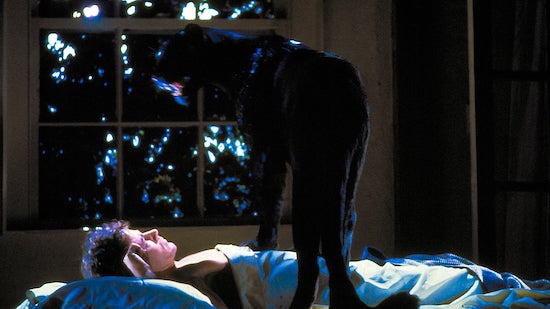For better or worse, the erotic thriller of the 1980s and 1990s has had a resurgence in popularity in the film world over the past few years. Though many of the works associated with this sub-genre were critically maligned at the time of release, a decade of sexless franchise movies based on comic books seems to have created a thirst for adult-oriented content (the kind that’s appropriate to watch in public), and the unique socio-political background of this older trend makes it particularly fascinating. After the upheavals of the 1960s and ‘70s, Hollywood’s output started to reflect a clash between America’s increasing sense of cultural liberation and the new reactionary politics that emerged in the Reagan era. While Fatal Attraction, Basic Instinct and a number of other movies were showing mainstream audiences a relatively unprecedented level of graphic physicality, their stories were mostly conservative. Exhibiting the hypocritical morality of their day, they’d allow viewers to enjoy the brief thrill of a seductive femme fatale or a transgressive erotic encounter, before ultimately resolving in a way that upheld the sexual status quo.
There were a few interesting exceptions to this rule, though. Ever the innovator, provocative writer/director Paul Schrader delved into the erotic thriller relatively early, and he came at it in his own idiosyncratic way. His 1982 remake of 1942’s Cat People continually troubles audience expectations about sexuality, in part due to the parallels it draws with an older genre of film, from a different – but equally conflicted – time period.
The original Cat People is one of the stranger and more underrated horrors from Hollywood’s Golden Age. Dracula and Frankenstein had been huge box office successes for Universal Pictures just over a decade before its release, and rival “Big 5” studio RKO started development on it in an effort to cash in on the monster movie craze. The project wasn’t a top priority, though; Cat People’s budget of around $135,000 was a little higher than the average B-movie’s, but considerably less than what Universal had spent on its most recent hit at the time, The Wolfman. And when development began, director Jacques Tourneur and producer Val Lewton had nothing more than a title to work with, following one studio exec’s observation that "nobody has done much with cats".
Without any pre-existing mythological or literary source material to draw upon, the filmmakers cobbled together an old East European folk tale to serve as the backstory for Cat People, concerning a group of medieval Christians who turned to devil worship and witchcraft to protect their village from invading warriors. The film’s protagonist Irena, a Serbian-born fashion illustrator now living in New York City, is convinced that she’s descended from this same supernatural evil. After she falls in love with straight-laced, all-American Oliver, a marine engineer, she’s forced to reveal her fear that she will transform into a vicious panther upon consummation of their marriage.
Cat People has a less-is-more approach to scares that proves to be surprisingly effective. As well as a financial necessity, its subdued atmosphere was a stylistic choice by the filmmakers, who wanted to create a more tasteful and intellectual horror picture than audiences were used to. The tone was also partly imposed by the censorious production standards of the era. The Hays Code had been introduced in 1934, and it forbade the depiction of realistic violence or sexual depravity in the cinema, in order to prevent this relatively new popular medium from corrupting the morality of its audience. Critics of the code might suggest that America’s ongoing racial segregation and newly-established Japanese internment camps had a more significant impact on the nation’s psyche than a bit of fake blood or exposed skin ever could, but the restrictions of the time nevertheless worked to Tourneur’s advantage.
Eschewing high-stakes suspense or extravagant special effects, he instead uses lighting and framing in a number of ingenious ways, to suggest hidden menace within everyday scenarios. It’s perhaps one of the first big screen horrors to fully recognise that the viewer’s imagination can create things much more frightening than any image can depict. The most famous example is a celebrated scene (recreated almost shot-for-shot in the Schrader remake) where one character visits a public swimming pool. Brief snatches of sound, ripped clothing, and shimmering water reflections on the ceiling combine to evoke her growing fears that a beast of some kind is stalking her in the shadows.
This idea of horror lurking just out of frame also extends to the film’s thematic concerns. Whether its implied supernatural forces are real or not, we get the sense throughout Cat People that Irena’s foreign heritage poses just as much of a danger to society’s established order. As a first-generation immigrant from rural Europe, she represents all the old-world traditions, spirituality, and suffering that a supposedly enlightened urban America of the 1940s was trying desperately to ignore or to leave behind. Oliver even sends her to visit an aloof, somewhat creepy psychiatrist to help rid her of her troubling past. But any Freudian worth their salt will tell you that the repressed will always return, in one way or another. After a number of teases and near-misses, it’s in her psychiatrist’s office that the dormant violence within Irena is fully unleashed, as the film finally reveals that the story of her family curse might have some basis in reality.

Cat People’s understated style baffled many viewers at the time, but its efforts to distance itself from the standard schlocky fare of the era won it some plaudits, and it garnered a cult following over the decades to come. Development began on a remake in the early 1980s, timed to coincide roughly with the 40th anniversary of the original release. Schrader was tapped to direct, and the project served as the follow-up to his early career peak, 1980’s one-two punch of American Gigolo (another erotic thriller that he wrote and directed) and Raging Bull (a co-writing credit, with Martin Scorsese’s frequent collaborator Mardik Martin).
With its depiction of repressed sexuality, animalistic violence, and the close links between the two, Cat People was ideal material for Schrader to work with. The weighty moralistic attitude of his religious faith usually informs his films to some degree, as individuals struggle to reconcile their place in society with their base desires, grappling with feelings of shame and guilt. Bearing this in mind, there are clear similarities between Irena and many of his other self-loathing protagonists, from Taxi Driver’s Travis Bickle to First Reformed’s Pastor Ernst Toller.
In the Schrader version of Cat People, the feline curse traces back far beyond medieval times, to a primitive ancient settlement. The lurid opening scene sees a woman sacrificed to a panther, as part of a ritual that seems to protect her tribe. We’re subsequently shown a different woman entering the big cat’s lair and locking eyes with it, apparently unafraid. A cut to the present day introduces us to Irena, who’s now portrayed with a fierce intensity by Natassja Kinski. She’s accompanied by Paul (Malcolm McDowell), a long-lost brother, who encourages her to embrace their shared heritage. He also insists that the only way they can prevent their transformations and protect other people from their family’s uncontrollable power is by mating with each other, thus introducing an incest element into the film’s heady psycho-sexual brew.
Another notable alteration in the Cat People remake is its change of setting. Whereas 1940s Irena was oppressed by the stifling normality of bourgeois life in mid-century New York City, the lawless, eerily empty New Orleans streets of the 1980s make her later counterpart simultaneously prey and predator. There’s something about the environment itself that brings out her inner beast, with its marriage of danger and the total freedom that accompanies it. Moody Giorgio Moroder synths on the soundtrack contribute further to the seedy, sensual vibe, evoking the glorious excess of an era that, at least superficially, seemed to indulge desires without concern for consequences.
There had to be some consequences, though, particularly for liberated women, or for anyone who didn’t conform to heteronormative ideals. Torn between her primal urges and her need for companionship and acceptance, Schrader’s version of Irena eventually takes action to allow herself some kind of peace, but it’s a highly ambiguous resolution. Shortly after she has sex with Oliver while tied naked to the bedposts (for his protection, obviously…), we see her pacing around behind the bars of a cage, now trapped permanently in her panther form. This is arguably a more positive ending than that of the original film, which saw her killed by another big cat at the zoo, but it’s still a bitterly ironic statement on the nature of romantic relationships, on conventional domesticity, and particularly on societal attitudes towards female sexuality.
Much like haunted Iraq War veteran William Tell in Schrader’s most recent effort, The Card Counter, 1982 Irena ultimately chooses a literal prison over an alienating modern world that has no place for her. If we look at both the older and newer versions of Cat People in their specific cultural contexts, we can see that America has a need to turn some people into monsters, in order to resolve its own deep-seated moral contradictions. But whether it’s presented as a low-budget horror movie or a steamy erotic thriller, this peculiar story acknowledges that most monsters are just misunderstood, perhaps even by themselves.


